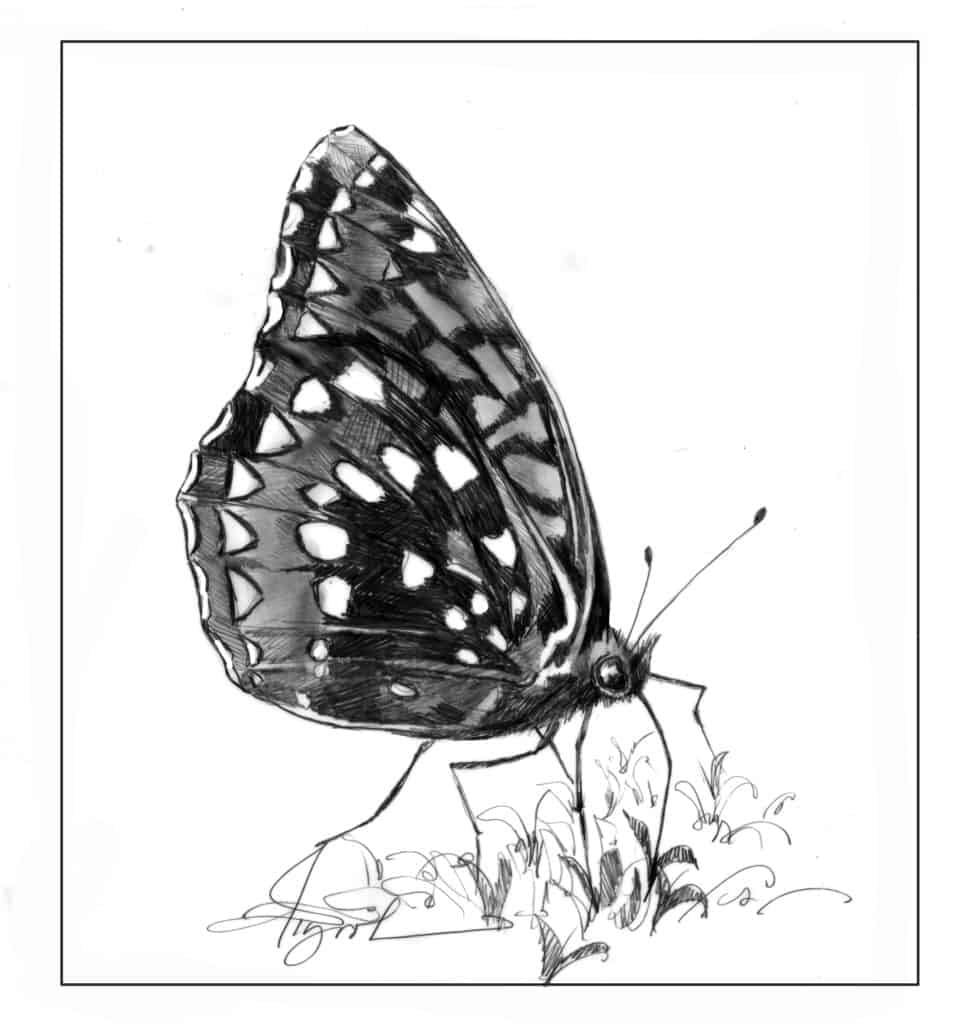
By Susan Shea
Recently I saw a beautiful orange butterfly speckled with black – a great spangled fritillary –feeding on orange hawkweed in a meadow. I observed it through binoculars, so as not to scare it off, then slowly crept closer. I watched as the butterfly unfurled its proboscis, a tube that functions like a straw, and inserted it into the flower. Then the fritillary sucked up nectar by rhythmically contracting muscles in its head. Sugars in the nectar provide energy for flight, defense, reproduction, and the butterfly’s other daily activities.
As the fritillary flew from flower to flower, it transported pollen between blooms. Butterflies and flowers have co-evolved: flowering plants have adapted to their pollinators, which in turn have adapted to the plants. Although butterflies are not as efficient at pollinating as bees, they are important pollinators of certain plants.
“And what could be a better combination of beauty than a butterfly and a flower?” asked Vermont-based field entomologist Bryan Pfeiffer. “Butterflies are basically day-flying moths. They branched off moths about 98 million years ago and exploited nectar from the exploding diversity of flowering plants.”
Flowering plants, or angiosperms, arose during the Cretaceous Period and diversified into 350,000 species over millions of years, leading to a great variety of butterflies. One example of this co-evolution is a butterfly’s proboscis. Scientists have found a correlation between the length of the proboscis (which is coiled below its head when not in use) and the depth of the flowers a butterfly feeds on. Butterflies with a long proboscis are able to extract nectar from long, tubular flowers.
Body mass and wing design also affect the type of flowers a butterfly visits. In one study, larger butterflies with heavier wings and long proboscises tended to feed on clusters of deep flowers where they obtained more nectar to power flight. Small butterflies with short proboscises fed on solitary flowers. All types of butterflies took advantage of masses of flowers with abundant, accessible nectar. Butterflies use color and scent to identify flower species. Some can see ultraviolet light, which helps to locate plants, and their antennae contain odor sensors.
Many butterflies consume other liquids in addition to nectar. The mourning cloak, a dark brown butterfly with pale yellow bands and blue spots, which emerges early in spring, is known for sipping sap, often from holes drilled in a tree by the yellow-bellied sapsucker. Some species like the juices of fermenting fruit. Red admirals, black butterflies with red bands and white spots on the wingtips, enjoy the crushed, rotting apples in my driveway in fall. Butterflies will even take up nutrients and salts from wet soil, carrion, and scat – a behavior known as puddling. In our region, large groups of white admirals and yellow tiger swallowtails will puddle in muddy areas along streambanks.
To bring butterflies to your yard so you can observe them, plant native, nectar-producing flowers. Butterflies are particularly attracted to brightly colored flowers growing in flat-topped clusters that provide a good landing pad and abundant nectar. Some of the best nectar plants for butterflies are milkweed, black-eyed Susan, Joe-Pye weed, butterfly weed, purple coneflower, goldenrod, and New England aster. Having flowers in bloom from spring through fall will ensure butterflies have a consistent food source. Fall flowers provide nectar for migrating butterflies such as monarchs.
Locate your butterfly garden in a sunny spot and place a rock in the middle to create a basking spot. A border of shrubs or trees, a fence, or stone wall will break the wind. To help butterflies reproduce, provide the host plants that female butterflies lay their eggs on and that their caterpillars eat. Larval food plants that host several butterfly species include aspen, black cherry, willow, and elm trees; red clover, milkweed, violet, and Queen Anne’s lace. Allowing part of your lawn to become a meadow with wildflowers will provide great habitat for butterflies.
“Watching butterflies on flowers is like heaven on earth,” said Pfeiffer – and the quintessence of summer.
Susan Shea is a naturalist, writer, and conservationist who lives in Brookfield. The illustration for this column was drawn by Adelaide Tyrol. The Outside Story is assigned and edited by Northern Woodlands magazine and sponsored by the Wellborn Ecology Fund of New Hampshire Charitable Foundation: nhcf.org.




